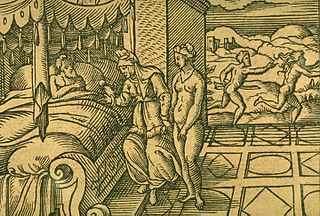
A chaplet is a headdress in the form of a wreath made of leaves, flowers or twigs woven into a ring. [1] It is typically worn on festive occasions and on holy days. In ancient times a chaplet also served as a crown representing victory or authority.

A chaplet is a headdress in the form of a wreath made of leaves, flowers or twigs woven into a ring. [1] It is typically worn on festive occasions and on holy days. In ancient times a chaplet also served as a crown representing victory or authority.
In ancient times, chaplets made from branches and twigs of trees were worn by victors in sacred contests; these were known as pancarpiae. [2] Later, flowers were used to "heighten the effect" with their color and smell. [2] Glyccra challenged Pausias to a contest where she would repeatedly vary her designs, and thus it was (as Pliny the Elder described it) "in reality a contest between art and Nature". This invention is traced only to later than the 100th Olympiad via Pausias paintings. [2] These "chaplets of flowers" became fashionable and evolved into the Egyptian chaplets using ivy, narcissus, pomegranate blossoms. According to Pliny, P. Claudius Pulcher [3]
In Chapter 5 of Naturalis Historia , titled “The great honour in which chaplets were held by the ancients”, Pliny explains how these head dresses were perceived:
Chaplets, however, were always held in a high degree of estimation, those even which were acquired at the public games. For it was the usage of the citizens to go down in person to take part in the contests of the Circus, and to send their slaves and horses thither as well. Hence it is that we find it thus written in the laws of the Twelve Tables: "If any person has gained a chaplet himself, or by his money, let the same be given to him as the reward of his prowess." There is no doubt that by the words "gained by his money," the laws meant a chaplet which had been gained by his slaves or horses. Well then, what was the honour acquired thereby? It was the right secured by the victor, for himself and for his parents, after death, to be crowned without fail, while the body was laid out in the house, and on its being carried to the tomb. [4]
Pliny continues the explanation to describe the severity in which the rules of the wearing of the chaplets were enforced by the "ancients":
Pliny notes that the statue of Marsyas was a meeting place for courtesans, who used to crown it with chaplets of flowers. [6] He also notes that when Emperor Augustus's daughter Julia placed a chaplet on the statue, she was acknowledging herself to be no better than a courtesan. [7]
The highest and rarest of all military decorations in the Roman Republic and early Roman Empire was the Grass Crown (Latin: corona graminea) . [8] It was presented only to a general, commander, or officer whose actions saved a legion or the entire army. Examples of this would be a general who broke the blockade around beleaguered Roman troops. The crown took the form of a chaplet made from plant materials taken from the battlefield, including grasses, flowers, and various cereals such as wheat, which was presented to the general by the army he had saved. [9]
The corona radiata, or "radiant crown" known best for adorning the Statue of Liberty, and perhaps worn by the Helios that was the Colossus of Rhodes, was worn by Roman emperors as part of the cult of Sol Invictus prior to the Roman Empire's conversion to Christianity. It was referred to as "the chaplet studded with sunbeams” by Lucian, about 180 AD. [10]

In Greek mythology, Cinyras was a famous hero and king of Cyprus. Accounts vary significantly as to his genealogy and provide a variety of stories concerning him; in many sources he is associated with the cult of Aphrodite on Cyprus, and Adonis, a consort of Aphrodite, is mentioned as his son. Some scholars have proposed a connection with the minor Ugaritic deity Kinnaru, the god of the lyre. The city Cinyreia on Cyprus was believed to have taken its name from Cinyras. According to Strabo, he had previously ruled in the city of Byblos in Phoenicia.
In Greek mythology, Acherusia was a name given by the ancients to several lakes or swamps, which, like the various rivers called Acheron, were at some time believed to be connected with the underworld, until at last the Acherusia came to be considered to be in the lower world itself.
In Greek mythology, the name Toxeus or Toxius refers to the following individuals:
In Greek mythology, Phemonoe was a Greek poet of the ante-Homeric period. She was said to have been the daughter of Apollo, his first priestess at Delphi, or of his possible son Delphus, and the inventor of the hexameter verses, a type of poetic metre.
Euryalus refers to the Euryalus fortress, the main citadel of Ancient Syracuse, and to several different characters from Greek mythology and classical literature:
In Greek and Roman mythology, the Astomi, also known as the Gangines, are an ancient legendary race of people who had no need to eat or drink anything at all. They survived by smelling apples and flowers and perfumes that they sprayed on their victims.

The Grass Crown or Blockade Crown was the highest and rarest of all military decorations in the Roman Republic and early Roman Empire. It was presented only to a general, commander, or officer whose actions saved a legion or the entire army. One example of actions leading to awarding of a grass crown would be a general who broke the blockade around a beleaguered Roman army. The crown took the form of a chaplet made from plant materials taken from the battlefield, including grasses, flowers, and various cereals such as wheat; it was presented to the general by the army he had saved.
Evenor is the name of a character from the myth of Atlantis and of several historical figures.

Laurices are rabbit fetuses prepared without evisceration and consumed as a table delicacy. The word is the plural of the Latin word laurex, assumed to have been borrowed from an Iberian source. The word is normally found in the plural number, since, due to their size, more than one would be served at a time. The rabbit was adopted by the Romans from Hispania, whence it spread over western Europe, as did likewise the custom of consuming laurices.
In Greek mythology, the name Anuothus may refer to:

A corolla is an ancient headdress in the form of a small circlet or crown. Usually it has ceremonial significance and represents victory or authority.
In Greek mythology, Car or Kar of the Carians, according to Herodotus, was the brother of Lydus and Mysus. He was regarded as the eponymous and ancestral hero of the Carians who would have received their name from the king. He may or may not be the same as Car of Megara
In Greek mythology, Chios may refer to two possible eponyms of the island of Chios:

In Greek mythology, Methe is the spirit and personification of drunkenness. She entered the retinue of Dionysus and was mentioned in association with the god or other companions of his. Methe was the daughter of Dionysus in some accounts.
The Marsaci or Marsacii were a tribe in Roman imperial times, who lived within the area of the Rhine–Meuse–Scheldt delta, under Roman domination.
In Greek mythology, Pandaie or Pandae was a daughter of Heracles who was born in India, and became the ruler of a kingdom in South India. In the account of the historian Megasthenes, she was a queen of the Pandya dynasty.
In Greek mythology, the name Hyperbius may refer to:

In Greek mythology, Aganippe was the name of both a spring and the Naiad associated with it. The spring is in Boeotia, near Thespiae, at the base of Mount Helicon, and was associated with the Muses who were sometimes called Aganippides. Drinking from her well, it was considered to be a source of poetic inspiration. The nymph is called a daughter of the river-god Permessus. Ovid associates Aganippe with Hippocrene.
In Greek mythology, Arabius or Arabus may refer to the following distinct or identical individuals:
Bratus is the name of a tree Pliny the Elder described in his Naturalis Historia:
Book 12, chapt. 39 —THE TREE CALLED BRATUS.
Hence it is, that they import from the country of the Elymæi the wood of a tree called bratus, which is similar in appearance to a spreading cypress. Its branches are of a whitish colour, and the wood, while burning, emits a pleasant odour; it is highly spoken of by Claudius Cæsar, in his History, for its marvellous properties. He states that the Parthians sprinkle the leaves of it in their drink, that its smell closely resembles that of the cedar, and that the smoke of it is efficacious in counteracting the effects of smoke emitted by other wood. This tree grows in the countries that lie beyond the Pasitigris, in the territory of the city of Sittaca, upon Mount Zagrus.